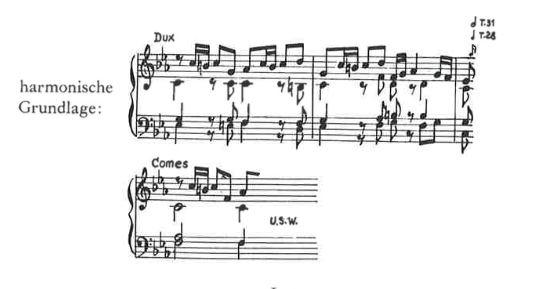Ludwig Czaczkes - Analyse des Wohltemperierten Klaviers
Czaczkes, L. (1956). Analyse des Wohltemperierten Klaviers: Form und Aufbau der Fuge bei Bach. Wien: P. Kaltschmidt.
The writer worked on form and cionstruction of Bach fugues of J.S. Bach since 1926, following an assignment given to him by Guido Adler and his dissatisfaction with published analyses of the WTK, especcially thos by Hugo Riemann.
He defines a Bach-fugue as follows: a Bach Fugue consists of a number of theme-entry groups (Durchführungen) of which the first one is called "exposition".
At least two theme-entries are required, possibly with so called "Themafreie Partien" or episodes. The maximum amount of theme-entries in one theme entry group is n + 1, n being the amount of parts of the fugue.
Incomplete theme-entry groups as proposed by Riemann are considered not to be correct. Also with Bach there are exceptions on generally accepted "rules"; for example not presenting all parts/voices in the exposition.
The theme
The fugue-theme is a rounded melodic-motivic unity which can be harmonized with a simple or more elaborate/extended cadence. C. also takes the so called "harmonische Grundlagen" of the theme into account (harmonic background or implied harmonic background).
An example from WTK I c-minor:

Order of voices/parts Stemmenvolgorde
Every voice has only one entry in each group of theme-entries with one exception: the supernumerary (überzählige) theme-entry. A specialty of Bach is the occurring of two consecutive entries in the same voice, the ""sich wiederholender Themaeinsatz". If this occurs they are counted as one entry.
A stretto counts for one entry. There is always a main voice with following voices. In the case of "crossover" (Kreuzung") both voices are counted. A theme which is broadened (with the rhythm proportionally enlarged) is always considered as the main voice. If a retrograde or theme rhythmically reduced is used, the one closest to the original is considered to be the main voice. If following voices do not change, the first one is the main voice.
Bach uses the cadence often to conclude a form section, to make segmentation. The importance of the cadence is not primarily harmonic but formal.
Answering the theme: the importance of distinction between dux and comes should not be overestimated. "Bach kennt nur eine Einheitsgestalt des Themas". If there is a real answer this distinction becomes even less relevant.
Episodes (Themafreie Partien)
The term episode or divertimento is not doing justice to the importance of episodes for the fugue as a whole. They are important for development, build-up and character of the fugue.
De following episodes can be discerned:
- The Durchführungszwischenspiel, occurring at the end of a theme-entry-group and which introduces new material.
- If theme-entry-groups coclude with the same episode, then this is called a Schlussspiel.
- The Expositionszwischenspiel occurs in the exposition before the supernumerary theme-entry and marks the end of a normal group of theme-entries. This episode can be used later on as Binnenzwischenspiel or as Durchführungszwischenspiel.
- The Binnenzwischenspiel is positioned clearly within a theme-entry-group and never at the beginning or end of it. If introduced in the exposition it doesn't change its function in the fugue later on.
- The durchführungseigene Zwischenspiel is connected to just one theme-entry group.
- An episode which occurs unchanged during a fugue is called an Einheitszwischenspiel. If Zwischenspiele change continually, then they are called Zwischenspiele in freier Art.
Repetition of theme-endings by means of a sequence pattern can be placed in one of the mentioned categories. If they are less autonomous then C. speaks of Themaverlängerung.
Scheinthemaeinsätze are used often as motivic material for episodes.
If the theme is concluded with a deceptive cadence, then this is called Kadenzerweiterung.
A coda (if present) should not be considered a (last) episode.
Van belang is, het coda duidelijk te onderscheiden van het (laatste) divertiment, dat nog bij de laatste doorvoering hoort.
Boundaries of theme-entry groups (Die Durchführungsbegrenzung)
The size of a theme-entry group can be determined with the following criteria:
- cadences
- the episodes and their place in the fugue as a whole
- Stimmrückgang at theme entries
- the order of voices at theme entries
- the length of theme-entry groups
- change of theme or thematic material
- change of contrapuntal technique
- introduction of new types of movement
- similar constructions at the end of theme-entry groups
- the inner structure of theme-entry groups
(Ad 3: if the amount of voices decreases at a new theme-entry as long as this theme-entry lasts, then this can be conisidered as the beginning of a new theme-entry group. In the WTC Bach only applies this at the beginning of a theme-entry group.
Aufbau der Teile
A binary overall structure occurs more often than a ternary overall structure(!).
Remark: “Der Aufbau der Fuge bei Bach ist eben nicht harmonischer Art, sondern polyphones Kombinationsspiel der Stimmen rein kontrapuntischer Herkunft."
Harmony and tonality in fugues by Bach: With regard to keys of theme-entries and their relation to the main key, the general pattern is that only keys occurs of which the tonic note is present in the main key.
Resulting in the following
scheme (blz. 35).
Motivic material
"Die genaue Kenntnis des in einer Fuge von Bach eingeführtenMaterials ist unbedingte Voraussetzung fur deren richtige Analyse und Interpretation".
Main principle: all the thematic/motivic material of the fugue arises out of the theme.
The use and development of thematic/motivic material can be achieved by:
- using motives of the theme
- contrapuntal modification of motives (retrograde, inversion, enlargement, etc.)
- change of intervals in motives
- inversion or mirroring of motives
- creating additional voices by Parallelführung
- reusing rhythmic patterns without belonging melodic contour
- Züge from the theme are conserved, reused and imitated
- a secondary voice used as basic material for episodes
- two scondary voices used as material for a Zwischenspiel
- etc.



